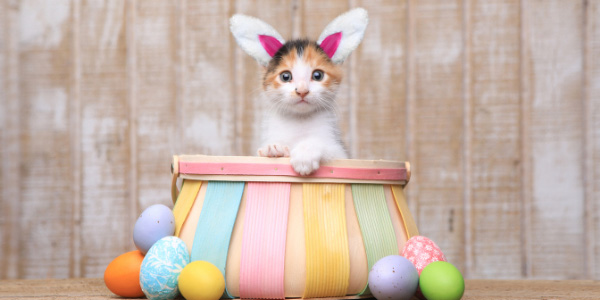 Easter is a great time to celebrate with family, but if you have a pet, there are a few extra things to be aware of that can be problematic.
Easter is a great time to celebrate with family, but if you have a pet, there are a few extra things to be aware of that can be problematic.
While we enjoy dressing up as the Easter Bunny, hiding eggs, and chowing down on Easter dinner and basket sweets, some common decorations, treats, and toys can be dangerous for our cats and dogs.
Let's look at what to watch out for and how you can prevent a trip to the emergency vet over Easter weekend.
Easter Flowers & Bouquets
Some of the plants and flowers that are commonly placed around the home and on tables this time of year can cause some serious problems for your pets. The easiest way to keep your cat or dog safe is to avoid having these flowers or plants around. And if you'd like to gift these beautiful yet dangerous plants to friends or family, make sure they don't have a cat or dog.
A few of the more common and dangerous Easter-associated plants and flowers are listed below. For a more extensive list of poisonous plants, check out Toxic and Non-Toxic Plants on the ASPCA's webpage, or our list of common plants that are toxic for dogs, and toxic plants for cats.
 Easter Lilies are Toxic for Cats
Easter Lilies are Toxic for Cats
The beautiful Easter lily is one of the most dangerous flowers you can have around your cat. Unfortunately, it’s also one of the most common found in homes around Easter and springtime. The Easter lily and several other varieties of ‘true lilies,’ will cause acute kidney failure in your cat. Your cat only needs to ingest a small amount or lick even just the pollen off their fur or paws, to be poisoned by these lilies. Lily toxicity is incredibly debilitating and often fatal for cats.
Click to read more on the dangers lilies pose to cats. Lilies do not pose a serious risk to dogs.
Cyclamen & Amaryllis
 Both of these beautiful plants are common around Easter time. The highest risk to pets comes from eating the roots of Cyclamen, though the flowers themselves can cause problems, too. Small bites may cause vomiting, drooling, and diarrhea, while eating a larger amount can result in heart rhythm abnormalities, seizures, and even death.
Both of these beautiful plants are common around Easter time. The highest risk to pets comes from eating the roots of Cyclamen, though the flowers themselves can cause problems, too. Small bites may cause vomiting, drooling, and diarrhea, while eating a larger amount can result in heart rhythm abnormalities, seizures, and even death.
 Both dogs and cats that eat part of the Amaryllis plant can suffer from vomiting, drooling, and abdominal pain. In some cases, they may even develop a sudden drop in blood pressure or breathing problems. Though all parts of the plant are toxic, the bulb, which is often exposed in these plants, is the most dangerous part for your pet.
Both dogs and cats that eat part of the Amaryllis plant can suffer from vomiting, drooling, and abdominal pain. In some cases, they may even develop a sudden drop in blood pressure or breathing problems. Though all parts of the plant are toxic, the bulb, which is often exposed in these plants, is the most dangerous part for your pet.
Hazards in the Easter Basket for Pets
Whether you’re planning to give your pet their own basket this Easter, or they just decide to help themselves to one meant for someone else, it’s important to be aware that there are a few things in the typical Easter basket that can be harmful to cats and dogs. To prevent curious noses from finding their way into your children's Easter baskets, keep them somewhere out of reach and have your dog in a separate and enclosed area while you hunt for and enjoy your sweets.
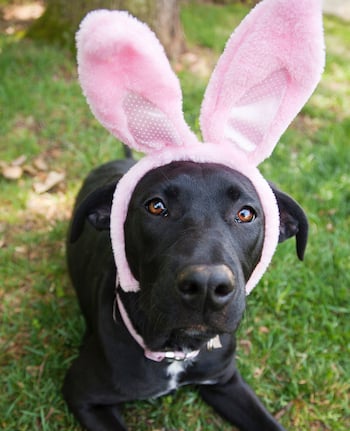
Easter Candy
Most people are aware of the danger that chocolate poses to your pets, but it’s not the only sweet treat that can do them harm! Many sugar-free gums and candies now contain xylitol, a sugar substitute that is highly toxic to dogs. Even a small amount of xylitol can cause a steep drop in your dog’s blood sugar, leading to seizures, and possible coma or death. Ingestion of any candy should lead to an immediate call to your veterinarian or one of the animal-specific poison control centers and should be considered very harmful until informed otherwise by a veterinarian or a certified veterinary technician.
While boxes of raisins don’t exactly scream Easter, some people put these candy alternatives in Easter baskets. Raisins, grapes, and currants can cause acute kidney failure in some dogs. It's still unknown what it is in these fruits that causes this toxicity, or why some dogs are more susceptible than others. It's simply better to not take the chance with your dog's health.
Thankfully, cats aren't usually too interested in candy, but chocolate, grapes, raisins, and dairy aren't good for cats and can lead to toxicity.
Easter Basket Grass
This common filler of Easter baskets is often too tempting to stay away from, particularly for cats. But if eaten, these plastic strings have a high likelihood of causing irritation or obstruction of your pet’s intestines. Such digestive problems will likely result in a decrease in energy level and appetite, as well as vomiting and diarrhea. And while the irritation may resolve with at-home care, it might require several days in the vet hospital, too. An obstruction, on the other hand, will most certainly require surgery to correct. This means a stay in the hospital for your pet and an extremely expensive vet bill. Prevention is better and cheaper for all! And if you're curious whether you should pull a "string" out of the backside of your pet, read "To Pull or Not to Pull" first.
Easter Eggs
You might be wondering, can an easter egg kill a dog or cat? Whether chocolate, plastic, or real, the eggs found in Easter baskets can cause a variety of problems for your pets. Plastic eggs can cause digestive and respiratory tract irritation or even obstruction when swallowed or inhaled. Chewed-off or broken pieces of these eggs can also lead to cuts on your pet’s paws and in their mouth.
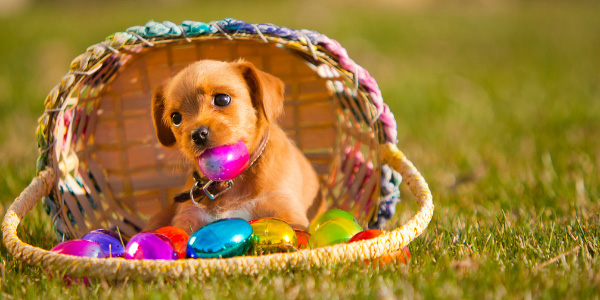
Hardboiled eggs often cause digestive issues when dogs sniff out and eat the eggs left over from the egg hunt. For your pet’s safety and your kid’s entertainment, consider writing down where you hid all the eggs, and then be sure they’ve all been collected before heading in for dinner.
Easter Dinner & Pets
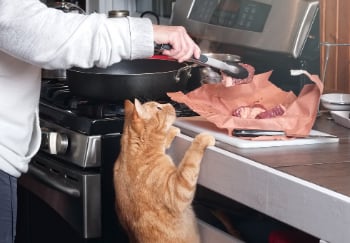 Many of the foods we eat can be bad for our pets – sometimes even in small quantities. The hustle and bustle of an Easter holiday dinner can make it more difficult to monitor what your dog or cat might be getting into, and an enterprising dog (or cat!) might take advantage of the commotion to counter surf and steal your Easter ham. And often your guests might find it hard to deny those pleading puppy eyes and sneak them a bite of something scrumptious under the table.
Many of the foods we eat can be bad for our pets – sometimes even in small quantities. The hustle and bustle of an Easter holiday dinner can make it more difficult to monitor what your dog or cat might be getting into, and an enterprising dog (or cat!) might take advantage of the commotion to counter surf and steal your Easter ham. And often your guests might find it hard to deny those pleading puppy eyes and sneak them a bite of something scrumptious under the table.
To make your life easier and protect your dog, you can keep them in a separate area or their safe space with a favorite toy or puzzle while you cook and eat.
For cats, the same goes, give a safe place to pass the time away from the temptation and commotion. This Ambush Interactive Cat Toy is a favorite of ours to occupy a cat's time.
Common Easter Foods That Are Bad for Pets
Pork Roast & Ham
The main problem with pork roast and ham is the amount of fat it contains. Many pets will develop digestive upset or pancreatitis from eating fatty foods. Ham also has high levels of salt, which can lead to neurologic problems for pets that eat too much.
Fat isn’t the only problem with these Easter entrees. Few pets are willing and able to resist the chance to play with (and eat) the twine that often holds these cuts of meat together. Eating twine can obstruct your pet’s digestive tract, so be sure to dispose of this string safely. 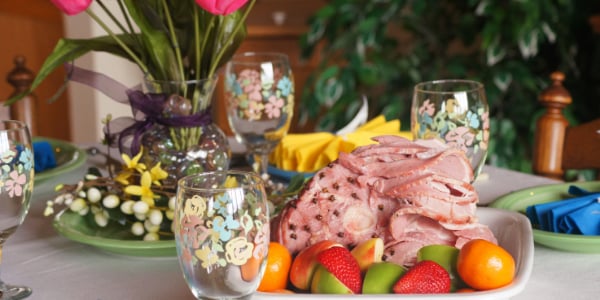
Bread Dough
When pets eat uncooked dough containing live yeast, they can suffer a variety of debilitating and potentially fatal problems as the live yeast becomes “active” in the warm, moist environment of their stomach. Much as it would do when left to rise in a cupboard or oven, the active yeast expands and can cause alcohol poisoning.
In some instances, the expanding dough can result in an obstruction of the stomach, which may require surgery. If you're baking your Easter rolls from scratch, put your dough in a closed oven, microwave, or on a high shelf to rise.
As mentioned earlier in this article, chocolate and raisins/grapes are toxic to dogs and cats. Also, raw eggs, onions, garlic, leeks, and chives are too.
 Easter should be fun and safe for all, and by being aware of possible pet dangers related to the holiday, you're already a step ahead. Having your pet in their safe space, puppy zone, or in a separate room is often the easiest way to ensure they don't get into something dangerous, so you can enjoy your Easter feast knowing they're safe.
Easter should be fun and safe for all, and by being aware of possible pet dangers related to the holiday, you're already a step ahead. Having your pet in their safe space, puppy zone, or in a separate room is often the easiest way to ensure they don't get into something dangerous, so you can enjoy your Easter feast knowing they're safe.



